Daffodils, Narcissi, Spring Bulbs, Daffodil Types
Easy to plant, Daffodils are extraordinarily rewarding every spring, with their bright, cheery blossoms warming our souls from the previous winter months. Long-lived, they naturalize and multiply year after year and offer a wide range of flower shapes and colors to pick from. Versatile, they are perfect for beds and borders, rock gardens, containers, or window boxes. They also make gardening easy. Once planted, nothing is left to do: these bulbs can stay right where they are and produce flowers year after year. As an added, most are fragrant, and all are deer and rodent-resistant.
Daffodils are divided into 13 types based on their unique characteristics, including the shape of the flower, the arrangement of petals, and the size of the cup. This classification helps gardeners and enthusiasts identify and choose the specific daffodil varieties that best suit their preferences and garden design, allowing for a diverse and stunning display of daffodils in different settings.
Trumpet Daffodils are quite traditional-looking with large flowers, one bloom per stem, and long trumpets (just as long or longer than the length of the perianth segments). This group offers a wide variety of colors (white, yellow, and dramatic color combinations) and shapes (wide, narrow, or flared trumpets). Blooming in early to mid-spring, they can be grown in any garden setting, sun or shade, or in the grass. Plant the smaller ones in rock gardens and the taller ones in drifts or dotted under trees where they will draw everyone’s attention.
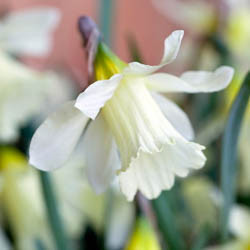
|
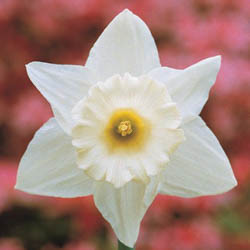
|
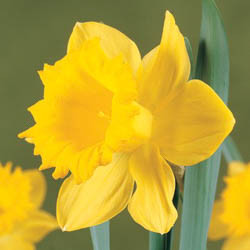
|
Large-cup daffodils present one single flower per stem with a cup (trumpet) that is more than one-third but less than equal to the length of the petals. This is one of the most popular groups of daffodils. Why? Several reasons account for their popularity. First, they offer a wide range of colors (white, yellow, pink, peach or red) and cup shapes: flat, ruffled, or trumpet-like. Adding unique charm and symmetry to the garden or containers, they typically produce large flowers, one bloom per stem, in mid-spring. Importantly, they are good for naturalizing and are reliably perennial, multiplying year after year.
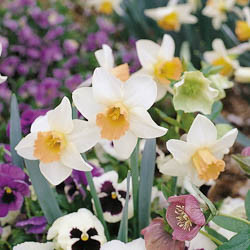
|
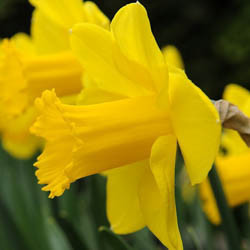
|
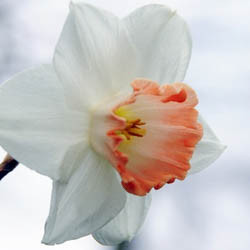
|
Small-Cupped Daffodils produce medium-sized flowers, one bloom per stem, characterized by a small cup or corona: not more than one-third the length of the petals. Mid-season bloomers, this group includes many attractive, bi-colored cultivars, adorned with perfectly formed, white, and pale petals, and usually strongly colored cups.
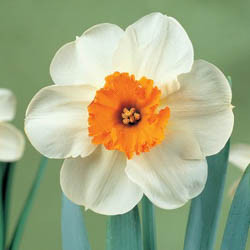
Narcissus ‘Barrett Browning’ |
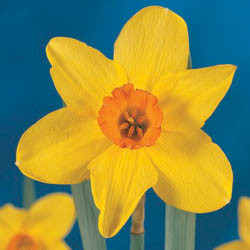
Narcissus ‘Birma’ |
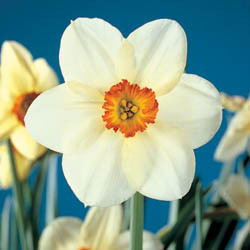
Narcissus ‘Verger’ |
Incredibly romantic and beautiful, Double Daffodils resemble peonies or carnations more than classic daffodils with their packed rows of petals and all their frills. This group includes either daffodils with a doubled trumpet or daffodils with a double row of petals or even both. Many cultivars are sweetly fragrant. They usually bear one flower per stem, but occasionally may have more. Flower colors range from yellow, and white to peach, pink or red and these lovely blossoms are usually expected in mid to late spring. Double Daffodils work especially well under flowering trees and shrubs.
.jpeg)
|
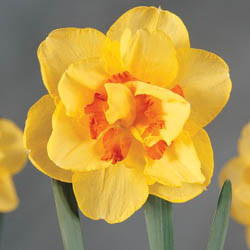
|
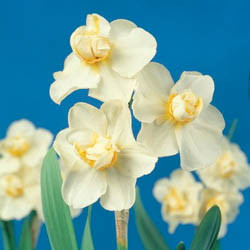
|
Triandrus Narcissi, sometimes called ‘Angels’ Tears’, produce up to 2-3 small to medium-sized flowers per stem in mid to late spring. Their distinguishing feature is that the perianth petals flare back and away from the bell-shaped cup so that the cup is more conspicuous. The delicate-looking flowers, white or yellow, are always angled downward. Usually strongly fragrant, these low-growing little daffodils have a definite preference for somewhat damp habitats. They are also frequently used in rock gardens.
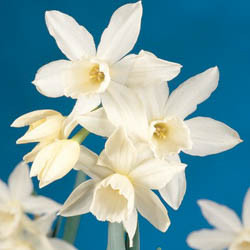
|
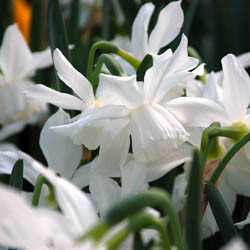
|
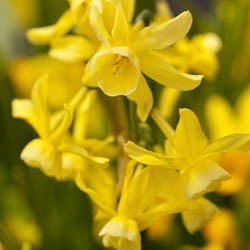
|
Elegant and graceful, the Cyclamineus or Miniature Daffodils feature small flowers, one per stem, with slightly to strongly swept-back petals and straight-sided trumpets. Sometimes, they resemble cyclamen, therefore the name of their group. Among the first hybrid daffodils to bloom, they can be admired from early to mid-spring and sometimes later in the season, depending on cultivars and weather conditions. More shade tolerant than most daffodil varieties, these Miniature Daffodils naturalize easily. Great choices for rock gardens, containers, and forcing.
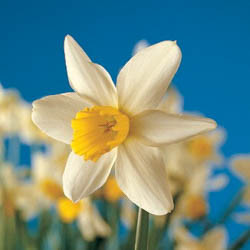
|
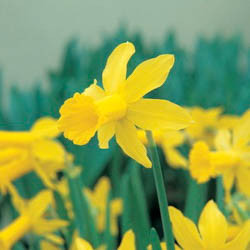
|
 sq.jpeg)
|
Loved since the 17th century, Jonquil Daffodils produce small flowers, 3 or more per stem, with short, wide petals held at right angles to cups. The cup of these daffodils is not that large: usually half the length of the petals. Strongly fragrant, their foliage is often rush-like. Blooming in mid-late spring, they are excellent for naturalizing and prefer sunny locations, warm soils, and humid conditions. Their heady fragrance has seduced many generations of gardeners!
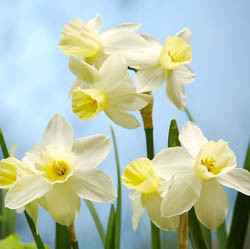 Narcissus ‘Sailboat’ Narcissus ‘Sailboat’ |
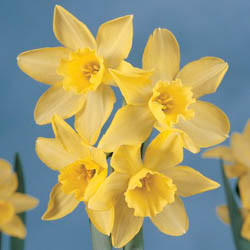 Narcissus ‘Pipit’ Narcissus ‘Pipit’ |
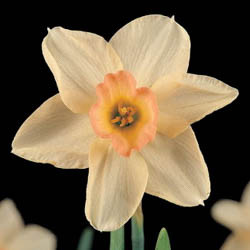 Narcissus ‘Bell Song’ Narcissus ‘Bell Song’ |
The Tazetta Narcissus group includes very short-cupped, sweetly fragrant, mid-sized daffodils bearing multiple flowers, up to 3-20 per sturdy stem. Many are not hardy to the more northern climates but are terrific performers in USDA Zones 5-9. Excellent for forcing (this division includes the world-famous but tender paperwhites), they also naturalize readily in wet-winter, dry-summer climates. Suitable as garden plants or for cutting, most bloom in mid-late spring.
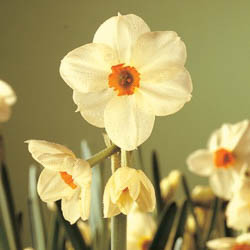 Narcissus ‘Cragford’ Narcissus ‘Cragford’ |
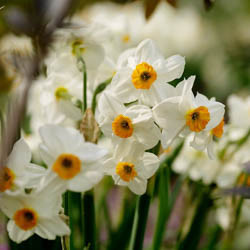 Narcissus ‘Geranium’ Narcissus ‘Geranium’ |
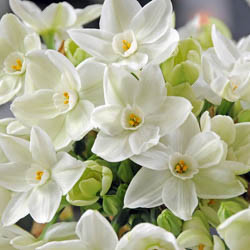 Narcissus ‘Paperwhite’ Narcissus ‘Paperwhite’ |
Large and powerfully fragrant, Narcissus poeticus and its hybrids produce elegant and simply beautiful flowers, adorned with glistening white petals, very small red-rimmed yellow cups, and green eyes. Blooming in late spring, usually one flower per stem, these daffodils thrive in damp soil and look wonderful naturalized in tall grasses or next to a few deciduous trees.
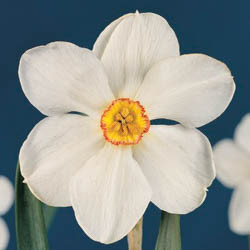 Narcissus ‘Actaea’ Narcissus ‘Actaea’ |
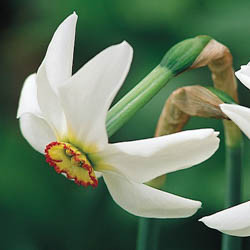 Narcissus Recurvus Narcissus Recurvus |
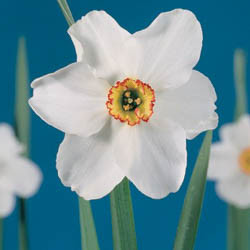 Narcissus Recurvus Narcissus Recurvus |
Reminiscent of a hoop petticoat caught in the wind in early to mid-spring, Narcissus bulbocodium is by far the most widespread of the hoop petticoat daffodils. The main characteristic of this charming daffodil is short, very narrow petals and huge, flaring, funnel-shaped cups. Low-growing, it blooms prolifically, 3-5 blossoms per bulb, over a long season. Its attractive foliage of dark green leaves, resembling clumps of chives, is almost evergreen. Thriving in sunny locations and acid soils, it is excellent for naturalizing as it multiplies quickly and self-seeds as well. Rock gardens and naturalized areas are ideal places to plant these dwarf daffodils.
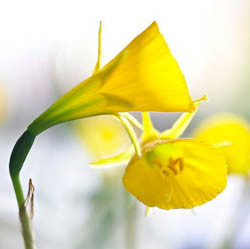
Narcissus Bulbocodium
Named after their split trumpet, these daffodils could be further classified as “Collar” if their petals are arranged in 2 rings of 3 or as “Papillon” if the petals are displayed in 1 ring of 6.
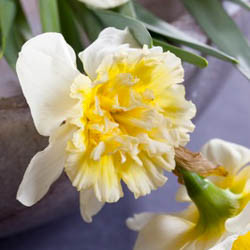 Narcissus ‘Valdrome’ Narcissus ‘Valdrome’ |
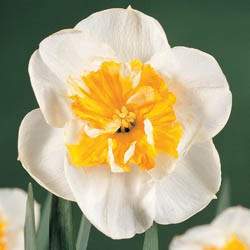 Narcissus ‘Dolly Mollinger’ Narcissus ‘Dolly Mollinger’ |
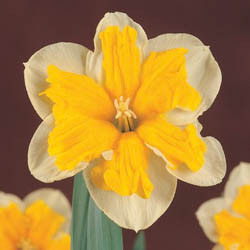 Narcissus ‘Orangery’ Narcissus ‘Orangery’ |
This group includes all other cultivars not fitting any of the above groups
| Hardiness |
3 - 9 |
|---|---|
| Plant Type | Bulbs |
| Genus | Narcissus |
| Exposure | Full Sun, Partial Sun |
| Season of Interest |
Spring (Early, Mid, Late) |
| Maintenance | Low |
| Water Needs | Average |
| Soil Type | Chalk, Clay, Loam |
| Soil pH | Acid, Alkaline, Neutral |
| Soil Drainage | Moist but Well-Drained, Well-Drained |
| Characteristics | Cut Flowers, Fragrant, Showy |
| Tolerance | Deer |
| Garden Styles | City and Courtyard, Informal and Cottage, Prairie and Meadow |
123rf
| Hardiness |
3 - 9 |
|---|---|
| Plant Type | Bulbs |
| Genus | Narcissus |
| Exposure | Full Sun, Partial Sun |
| Season of Interest |
Spring (Early, Mid, Late) |
| Maintenance | Low |
| Water Needs | Average |
| Soil Type | Chalk, Clay, Loam |
| Soil pH | Acid, Alkaline, Neutral |
| Soil Drainage | Moist but Well-Drained, Well-Drained |
| Characteristics | Cut Flowers, Fragrant, Showy |
| Tolerance | Deer |
| Garden Styles | City and Courtyard, Informal and Cottage, Prairie and Meadow |
Create a membership account to save your garden designs and to view them on any device.
Becoming a contributing member of Gardenia is easy and can be done in just a few minutes. If you provide us with your name, email address and the payment of a modest $25 annual membership fee, you will become a full member, enabling you to design and save up to 25 of your garden design ideas.
Join now and start creating your dream garden!
Create a membership account to save your garden designs and to view them on any device.
Becoming a contributing member of Gardenia is easy and can be done in just a few minutes. If you provide us with your name, email address and the payment of a modest $25 annual membership fee, you will become a full member, enabling you to design and save up to 25 of your garden design ideas.
Join now and start creating your dream garden!